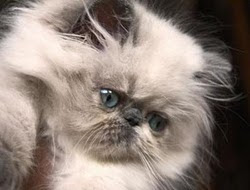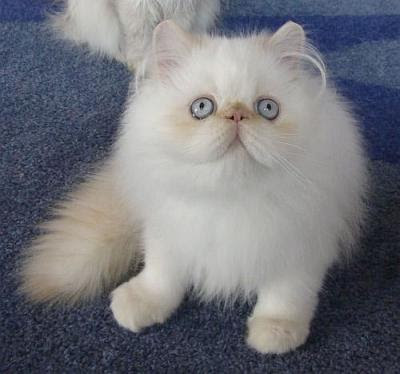There are seven Persian color classes that are recognized by the CatFanciers Association (CFA): solid colors, bicolor, calico, tabby, silver and golden, shaded andsmoke, and Himalayan. Persian kittens in the United States 12 lbs .
Temperament
The Himalayan cat is a breed oflong-haired cat identical in typeto the Persian, withthe exception of its blue eyes and its point coloration, which were derived from thecrossing of the Persian with the Siamese. In Europe they are referred to as Colourpoint Persians.
While the Himalayan is considered a breed separatefrom the Persian by The International Cat Association, itis grouped together with the Persian and Exotic Shorthair (shorthairedversion of the Persian) under a "Persian Breed Group standard". The Cat Fanciers' Association considersthe Himalayan a color variation of the Persian rather than as a separate breed,although they do compete in their own color division.
Temperament
These cats are sweet-tempered, intelligent andgenerally very social and good companions. Because of their heritage from theSiamese cats they tend to be more active than Persians.
Himmies, as fanciers call them, are perfect indoor catcompanions. They are gentle, calm, and sweet-tempered, but they possess aplayful side as well. Like the Siamese, Himalayans love to play fetch, and ascrap of crumpled paper or a kitty toy will entertain them for hours.Himalayans are devoted and dependent upon their humans for companionship andprotection. They crave affection and love to be petted and groomed .
The average length of pregnancy in the cat is 65 days,but it can vary from 61 to as long as 71 or 72 days.
We rely on our veterinarian to make the determination as to when our kittens cango home. Between 10-12 weeks of age (at the earliest) the vet will issue a healthcertificate for air travel or a health report card for local delivery. In
addition to the Alameda East endorsement ofhealth, we strive to properly socialize the Baby so he or she has the needed skills for a comfortable transitionfrom the nursery to the new experience of interacting with his or her new family. For these reasons, allof the kittens are evaluated on an individual basis.
Trainingyour kitten
Youhave a new kitten- now it is time for training your kitten. Purrinlot wishes tohelp you on this quest for kitten training and adapting your new kitten to yourhome.Trainingyour Kitten to do tricks, to understand your words, and to know what to do -when- and where is pretty easy.
First-Never yell or fuss- kittens are babies and tend to not be your friend when theyfeel unloved. Spoil them as new born human babies - this is how you have a bestfriend lap cat for years to come.
Second,the first few weeks your new kitten is in your home - hold, love, and sweetbaby talk to the kitten - this kitten training technique will help the catsocialize and bond to you.
Somekittens feel the need to jump down- feeling uncomfortable with being held.That's ok- simply let the kitten down and a few minutes later- try again. Do thisas much and as often as you can during the first 3 weeks of bringing the newkitten into your home.
Whenkitten training: It takes 3 weeks to create a habit, and 3 weeks to break ahabit.
Third.Make sure to show kitten where all of his new stuff is - theplace to scratch- help by showing him how to use it. Do this overand over until kitten does it all on his own.
Litter Problems
Himalayan-Persians are notoriously difficult to litter train because urine and feces get caught on their long fur. Himalayans also have a lot of fur on their paws, so soiled litter can get stuck on the paws. Himalayans, like all cats, like to keep clean and may avoid a litter box because they do not want soiled litter stuck to their fur. Because of their pushed-in faces, Himalayans have more difficulty grooming themselves than cats with longer faces. Changing the litter may encourage the cat to use the liter pan again, but grooming the cat every day and making sure the fur is trimmed will keep the cat feeling clean enough to use the litter pan again.
Grooming
The Cat Fanciers' Association recommends that Himalayan-Persians be groomed (combed and brushed) at least once a day. This not only helps the cat keep clean and straightens out any tangles but also helps the cat get used to people. Getting rid of dead hair will help prevent hairballs. Ideally, grooming should start as soon as a kitten is weaned. For extremely matted Himalayans, there is no alternative but to have the cat shaved. The fur will grow back. Shaving or trimming is also recommended for cats living in hot, humid environments.
Health Problems
- Make sure you have a vet before you bring a Himalayan home, and plan on going to the vet often throughout the cat's life. The ASPCA Complete Guide to Cats lists several common health problems in most Himalayans, which is why they must be kept indoors. The most common is tearing eyes or blocked tear ducts. These cats need their faces wiped clean every day. Other eye problems include inflammation of the third eyelid and inverted eyelids. Himalayans often have breathing problems because of their pushed-in faces. They also commonly get kidney problems, skin problems and genetic deformities of the mouth, which can lead to periodontal disease. When grooming, check for any strange symptoms like bald patches, excessive drooling or strange growths. When caught early, most Himalayan health problems can be managed.









No comments:
Post a Comment